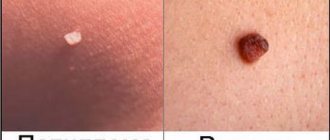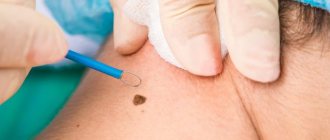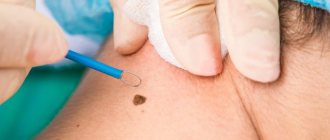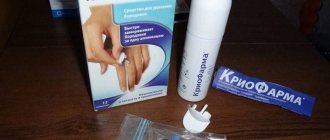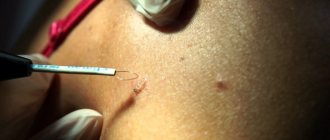People of all ages face problems that require the intervention of a medical specialist for health reasons or for aesthetic reasons. One of the reasons for visiting a medical clinic is the removal of moles using electrocoagulation. This method is used in cosmetology and medicine, as it has low trauma and a short rehabilitation period. Otherwise it is also called - removal of moles with an electric knife. The procedure requires sterility, so it is carried out only in medical institutions.
Removal of moles by electrocoagulation in our clinic
Our medical center, along with others, uses this method of treatment, since cauterization of moles with an electric knife is convenient and painless for patients, and also has a number of other advantages:
- minimal percentage of development of undesirable consequences after removal
- no need for hospitalization
- the opportunity to conduct a histological examination of the tumor
- short recovery period
- no need to use general anesthesia
- The procedure takes no more than 20 minutes
- positive aesthetic result
- affordable price of service
Removal of moles using electrocoagulation is indicated for most patients who contact our clinic to solve this problem. However, it is not always possible to use an electric knife for such purposes. You can find other methods and indications for their use here and here. Before performing electrocoagulation, it is necessary to identify the presence of contraindications.
Interesting fact! Moles can appear and disappear without a trace throughout your life. On average, there are from 25 to 100 nevi of various shapes and sizes on the human body.
Advantages of the method
The process of radio wave removal of benign tumors does not cancel or replace other methods of performing surgical operations, but in many cases it is the preferred method. Thus, removal of a cervical polyp by electrocoagulation is the price of obtaining the following advantages:
- speed of operation;
- minimal level of trauma and tissue necrosis in the wound area;
- no complications due to the sterilizing effect;
- painlessness and high precision of the procedure;
- surgical wound healing after electrocoagulation, rapid tissue regeneration;
- eliminating the possibility of relapse;
- absence of pain in the postoperative period.
These advantages apply to all options for using Surgitron - removal of papillomas, condylomas, cysts on the internal and external genital organs, treatment of erosion and cicatricial deformation of the cervix, dysplasia, hypertrophy.
In cosmetology, there is an additional advantage of using electrocoagulation when removing papillomas, nevi, warts, fibroids, etc. – cosmetic effect. The operation does not leave scars or scars, and treatment of the wound after removal of the tumor consists of protecting it from water and disinfection with an antiseptic.
Preparing to remove moles with an electric knife
Proper preparation is the key to the successful completion of every medical procedure. Cauterizing a nevus with an electric knife is no exception, but in most cases does not require special preparation. We prescribe tests before the procedure for removing a nevus using electrocoagulation if you have a history of heavy bleeding or there are doubts about the benignity of the mole. In the above situations you will need:
- Clinical blood test.
- Coagulogram (determination of blood clotting indicators).
- Blood test for tumor markers.
Since removal of moles with an electrocoagulator does not require general anesthesia, there is no need for a “fasting” regime on the eve of surgery.
Types of coagulation
There are different methods of coagulation:
Electrocoagulation . Removal of a mole or wart using this method is carried out in such a way that after completion of the procedure, the biomaterial can be sent for histological examination. By freezing the tumor with liquid nitrogen, this possibility is eliminated.
An electrocoagulator is used to remove moles. This device consists of two parts - an electric current generator and an electrode to which high-frequency current is supplied. As a result of cauterization, the mole or papilloma moves away from the skin, leaving a barely noticeable wound. After some time, a crust will appear on the treated area, which will then come off without leaving a trace. If a large mole is removed, a light spot will remain in its place after healing, but then it will take on the normal skin color.
After cauterization, a small thermal burn is possible around the removed tissue. After the removal procedure, you need to treat the skin with healing creams and ointments for a week.
Radio wave coagulation . The method of operation of a radio wave coagulator is based on the conversion of electric current into radio waves. Radioknife can be used to remove warts on particularly sensitive skin. The advantage of the method is that the radio knife does not cause burns. The tumor is removed quickly, the whole process takes about five minutes, and immediately after this the patient can go home.
Both methods are used using local anesthesia.
How does mole burning work?
The procedure for removing a nevus with an electric knife includes the following steps:
- Visual inspection of the birthmark.
- Treating the surgical field with a skin antiseptic to prevent infection from entering the wound.
- Local application of a local anesthetic.
- The procedure for removing a nevus using an electric knife.
- Treatment of postoperative wound.
Burning out a nevus with an electric knife takes place in one movement, so you will not feel pain or burning. Some patients experience a slight tingling sensation where the device comes into contact with the skin.
Important! Self-removal of skin tumors is strictly prohibited. This can lead to the development of undesirable consequences such as inflammation, sepsis (blood poisoning), skin cancer. If necessary, you should contact a specialist at a medical clinic.
What are the methods for removing warts?
When a patient goes to a medical institution with similar problems, he is offered removal in different ways. As a rule, these are laser coagulation, liquid nitrogen or cryodestruction (removal occurs by freezing), electrocoagulation (new growths are burned out with electric current), radio wave technique (removal with high-frequency radio waves) and surgery (warts are cut out with a scalpel).
Naturally, before making a choice in favor of any technique, it is necessary to fully study its principle and consult with your doctor. Perhaps in your case the chosen method of getting rid of warts is not suitable for you.
Contraindications to burning moles
New growths on the skin can be benign or malignant. Removing moles with a coagulator is considered safe provided that the nevus does not show signs of developing a cancerous tumor. The doctor determines the primary signs during a visual examination. You cannot remove a nevus using an electric knife if you suspect the formation of a malignant process. Also contraindications include:
- bleeding disorders
- intolerance to electrical procedures
- allergic reactions to local anesthetics
- herpetic infection in the acute phase
- an inflammatory skin disease at the site where a mole was burned out with an electric knife
Any such case must be eliminated before electrocoagulation is performed.
Pros and cons of electrocoagulation
Content:
- What are the methods for removing warts?
- Pros and cons of electrocoagulation
- In what cases is electrocoagulation contraindicated?
- How is electrocoagulation performed?
- Rehabilitation after electrocoagulation
Each technique has its advantages, but electrocoagulation has the most positive aspects. Firstly, the procedure is quite quick compared to others, and at the same time it is absolutely painless. During the removal of skin formations, there is completely no risk of bleeding, and this, in turn, prevents infection of wounds and the onset of the inflammatory process.
Electrocoagulation is considered one of the safest removal methods, since only warts are burned off by electric current, and the skin around them is not affected. After such procedures, the patient recovers quickly, and the rehabilitation period passes faster. In isolated cases, a relapse may occur. Also, an equally significant advantage is the price of the procedure, because compared to others, it costs several times less.
As medical practice shows, some time after removing a wart using electrocoagulation, as a rule, there are no repeated growths in this place.
If we consider the negative aspects of this technique, we can highlight only one disadvantage. Sometimes patients experience itching and burning at the site of the burn. As experts explain, this is the result of individual intolerance to local anesthetics.
Refusal to cauterize a mole
Refusal to remove the tumor in some cases leads to undesirable consequences. This is especially true for protruding birthmarks located in those parts of the body that can be easily injured. This, in turn, leads to heavy bleeding or degeneration of the nevus into a cancerous tumor. If the mole is located on an open area of the body, constant exposure to ultraviolet rays may also contribute to this. These complications pose a serious threat to human health. Therefore, it is better to seek medical help from a specialist in time and undergo, if not removal, then at least a visual examination and obtain a conclusion that the mole is not a malignant formation. But remember that you can 100% declare this only after histological analysis.
Interesting fact! There is a belief that a birthmark is located above a diseased organ and warns a person about a possible disease. Official medicine does not find confirmation of this. Most likely, this belief came to us from Eastern practices.
Electrocoagulation of blood vessels using the Surgitron apparatus in Moscow
Despite many positive qualities, radio wave surgery has certain contraindications:
- installed pacemaker;
- menstruation;
- period of gestation and breastfeeding;
- a number of chronic diseases and infectious diseases in the acute stage;
- malignant nature of the tumor or mole;
- oncology.
In the MedBioSpectrum clinics in Moscow and Ramenskoye, the price for removing erosion by electrocoagulation, papillomas, moles, etc. depends on several factors. You can find out detailed information and choose a convenient time to visit a doctor.
Is a relapse possible after removing a mole with an electric knife?
After surgery using the coagulation method, in most cases there is no relapse. The occurrence of complications is possible only if the technique of performing the manipulation is violated. This happens, for example, when there is insufficient tissue capture. As a result, pigmented cells remain in the deep layers of the skin and a new mole appears at the site of removal. This point usually depends on the skill of the doctor. We also employ a certified doctor, whose experience you can find here.
In our clinic you will receive professional medical services. A specialist doctor will examine the tumor and give recommendations for treatment. Together with the doctor, you can determine the tactics of further actions and sign up for the necessary medical procedure, or do it right away.
If you still have questions, you can ask them to the administrator by phone listed on the website or request a call back. We warn you that administrators have general medical education and cannot always help with the details and subtleties of certain procedures. For a detailed consultation, make an appointment with your doctor.
Primary source honey / September 2018
What is tumor removal using electrocoagulation?
The Surgitron device was invented and put into mass production in 1973 in the USA, and approved for use in the Russian Federation in 1995. The essence of its action is the emission of high-frequency (3.8-4.0 MHz) radio waves with a certain energy reserve by surgical electrodes with a diameter of only 50-150 microns. Tissue cells, upon contact with radio waves, absorb energy, resulting in the evaporation of intracellular fluid and achieving precision (high-precision) tissue dissection.
Cold and chemical removal of warts, moles, condylomas: there are more disadvantages than advantages
Cryodestruction
- exposure to the formation of a refrigerant (usually liquid nitrogen), freezing at a temperature of - 190 degrees, sufficient to destroy the tissues of the formation. Unlike a scalpel and current, cryodestruction does not leave scarring, so it can be used on any area of the skin and mucous membranes, even on the cervix. Liquid nitrogen is used in the treatment of erosion in nulliparous women.
The cold itself “freezes” the tissue, so anesthesia during cryodestruction is not necessary. This makes the technique convenient for treating patients who are allergic to anesthetics.
The main disadvantage of the method is the impossibility of accurately adjusting the depth and area of penetration of the coolant into the tissue. With weak treatment, unremoved cells remain, leading to relapse, and too deep treatment leads to the destruction of melanin pigment and the appearance of hypopigmentation - white spots that are difficult to get rid of.
After unsuccessful cryodestruction, poorly healing blisters and ulcers appear on the skin, caused by frostbite of the tissue around the removed formation.
Cauterization with various chemical solutions works in approximately the same way - feresol, condiline, verrucacid and other drugs that act on the skin with acids, alkalis and aggressive organic components (phenol, tricresol).
The disadvantage of their use is low selectivity. Along with the altered tissues, healthy ones that are affected by the substance also suffer, and sometimes part of the formation remains, leading to a relapse. This situation is especially dangerous when removing moles. After a chemical burn, nevi that are not completely removed become inflamed and can develop into an aggressive cancerous tumor - melanoma. The chemical components included in the preparations are dangerous for people with a tendency to allergic reactions.
Currently, agents are used to remove tumors that have an antiviral effect. They are effective against papillomas and warts, but growths of non-viral origin, such as moles or hemangiomas, cannot be removed with their help.




